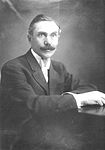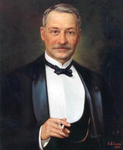
The Progressive Conservative Party of Saskatchewan is a right-of-centre political party in the Canadian province of Saskatchewan. Prior to 1942, it was known as the Conservative Party of Saskatchewan. Members are commonly known as Tories.

The Saskatchewan general election of 1905 was the first provincial election in the newly created Canadian province of Saskatchewan. It was held on 13 December 1905 to elect members of the Legislative Assembly of Saskatchewan. Walter Scott led the Liberal Party of Saskatchewan to victory over the Provincial Rights Party of Frederick W. A. G. Haultain, and became the first Premier of the new province.

The Saskatchewan general election of 1912 was the third provincial election in the Canadian province of Saskatchewan. It was held on July 11, 1912 to elect members of the Legislative Assembly of Saskatchewan. Premier Walter Scott led the Liberal Party of Saskatchewan to a third term in office with a significant increase in the share of the popular vote. The opposition, now renamed from the Provincial Rights Party to the Conservative Party of Saskatchewan and led by Wellington Bartley Willoughby, lost both votes and seats in the legislature.

The Saskatchewan general election of 1917 was the fourth provincial election in the Canadian province of Saskatchewan. It was held on June 26, 1917, to elect members of the Legislative Assembly of Saskatchewan.

The Saskatchewan general election of 1921 was the fifth provincial election held in the Canadian province of Saskatchewan. It was held on June 9, 1921 to elect members of the Legislative Assembly of Saskatchewan.

The Saskatchewan general election of 1925 was the sixth provincial election held in the Canadian province of Saskatchewan. It was held on June 2, 1925 to elect members of the Legislative Assembly of Saskatchewan.

The Saskatchewan general election of 1938 was the ninth provincial election held in the Canadian province of Saskatchewan. It was held on June 8, 1938, to elect members of the Legislative Assembly of Saskatchewan.

The Saskatchewan general election of 1944 was the tenth provincial election in the Canadian province of Saskatchewan. It was held on June 15, 1944 to elect members of the Legislative Assembly of Saskatchewan.

The Saskatchewan general election of 1967 was the sixteenth provincial election held in the Canadian province of Saskatchewan. It was held on October 11, 1967, to elect members of the Legislative Assembly of Saskatchewan.

The Saskatchewan general election of 1975 was the eighteenth provincial election held in the Canadian province of Saskatchewan. It was held on June 11, 1975, to elect members of the Legislative Assembly of Saskatchewan. Blakeney and the NDP were re-elected to a majority government.

The Saskatchewan general election of 1978 was the nineteenth provincial election in the Canadian province of Saskatchewan. It was held on October 18, 1978, to elect members of the Legislative Assembly of Saskatchewan.

The Saskatchewan general election of 1982 was the twentieth provincial election held in the Canadian province of Saskatchewan. It was held on April 26, 1982, to elect members of the Legislative Assembly of Saskatchewan.

Athabasca is a provincial electoral district for the Legislative Assembly of Saskatchewan, Canada. It is located in the extreme northwest corner of the province. The major industries are tourism, mineral extraction, forestry, commercial fishing and trapping. The Cluff Lake uranium mine is located in this constituency, as well as the Athabasca Sand Dunes Provincial Park and the Clearwater River Provincial Park. The major communities are La Loche, Île-à-la-Crosse and Buffalo Narrows with populations of 2,136, 1,268 and 1,137 respectively.

Swift Current is a provincial electoral district for the Legislative Assembly of Saskatchewan, Canada. Located in southwestern Saskatchewan, it was created for the 2nd Saskatchewan general election in 1908.
Saskatoon City was a provincial electoral division in the Canadian province of Saskatchewan. This constituency existed from 1908 to 1967. It was the riding of Premier James T.M. Anderson.

Arm River is a provincial electoral district for the Legislative Assembly of Saskatchewan, Canada. This constituency is located in south central Saskatchewan. Revived as a result of the 2013 revision of Saskatchewan's electoral districts, it was last contested in the 2016 election.
Doyle Vermette is a Canadian politician. He is a member of the Legislative Assembly of Saskatchewan, representing the electoral district of Cumberland as a member of the New Democratic Party. He was first elected in the 2007 general election, and was most recently re-elected in the 2016 general election.
Canora is a former provincial electoral district for the Legislative Assembly of the province of Saskatchewan, Canada, centred on the town of Canora. This constituency was created before the 2nd Saskatchewan general election in 1908. Dissolved in 1934, the district was reconstituted before the 9th Saskatchewan general election in 1938.
Pelly is a former provincial electoral district for the Legislative Assembly of the province of Saskatchewan, Canada. Located in east-central Saskatchewan, it was centered on the village of Pelly. The riding was created before the 2nd Saskatchewan general election in 1908, and dissolved before the 23rd Saskatchewan general election in 1995. This constituency elected the first woman to the Saskatchewan legislature: Sarah Ramsland.
Weyburn was a former provincial electoral district for the Legislative Assembly of the Canadian province of Saskatchewan, from 1908 to 1995.















